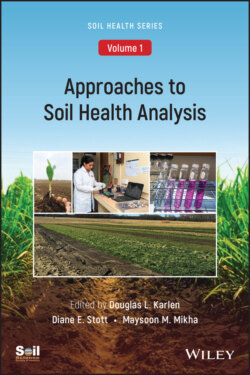Approaches to Soil Health Analysis, Volume 1

Реклама. ООО «ЛитРес», ИНН: 7719571260.
Оглавление
Группа авторов. Approaches to Soil Health Analysis, Volume 1
Table of Contents
List of Tables
List of Illustrations
Guide
Pages
Soil Health Series: Volume 1 Approaches to Soil Health Analysis
Dedication
Foreword
References
Preface
References
1 Soil Health: An Overview and Goals for These Volumes
Synopsis of Two‐Volume Book
Introduction
Why is Soil Health Important?
Soil Health Indicators and Methods
Need for Standardization
Interpretation of Soil Health Information
Utilizing Soil Health Assessments to Inform Soil Management Decisions
Minimizing Soil Disturbance
Maximizing Soil Cover
Maximizing Biodiversity
Maximizing the Presence of Living Roots
Summary and Conclusion
References
Note
2 Evolution of the Soil Health Movement
Introduction
Pre‐20th Century Soil Awareness
From 1900 to 1970
From 1970 to 2000 – Soil Quality Emerges. Concept Development
Soil Quality Assessment
21st Century Developments in Soil Health
References
3 The Utility and Futility of Soil Health Assessment
Chapter Overview
Introduction
Definitions
Opportunities for Implementing Soil Health Approaches
Comparison groups
Scale
Analytical Methods
Degrees of Change
Soil Health Limitations
Conclusions
References
4 Metadata: An Essential Component for Interpreting Soil Health Measurements
Methods and Frequency. Site Description
Soil Characterization
Experimental Descriptors
Climate and Weather
Management
Tillage
Cropping System
Amendments
Crop Management
Livestock Management
Sample Collection, Preparation, Storage, and Analysis
Discussion
Summary
Acknowledgments
References
Note
5 Soil Health Assessment of Agricultural Lands
Summary
Overview of Assessments
Assessment Frameworks. Initial Soil Health Frameworks
Soil Health Cards
Soil Conditioning Index (SCI)
AgroEcosystem Performance Assessment Tool (AEPAT)
Rangeland and Forestland Assessment
Soil Management Assessment Framework (SMAF)
Comprehensive Assessment of Soil Health (CASH)
Land‐Potential Knowledge System (LandPKS)
Evolving Soil Health Assessment Activities
References
6 Soil Health Assessment of Forest Soils
Introduction
Ecosystem Examples. Agroforestry
Carbon Sequestration
Soil Physical Indicators
Soil Biological Indicators
Soil Enrichment and Decontamination
Tropical Forests
Environmental Gradients and Future Climate Projections
Tropical Soil Chemical and Biological Properties
Earthworms as Bioindicators
Temperate Forests
The North American Long‐Term Soil Productivity Study
Temperate Forest Soil Health
Elevated Carbon Dioxide
Fire
Thinning or Bioenergy Harvests
Using National Forest Inventory and Analysis Data to Assess Forest Soil Health
Forest Soil Health Data Limitations and Management Implications
Climate Change, Fire Shifts, Invasive Species
Conclusion: Criteria and Indicators for Monitoring Forest Soil Health
Summary
Acknowledgments
References
7 A Risk‐Based Soil Health Approach to Management of Soil Lead
Introduction
Urban Soil Lead Assessment and Human Exposure
Soil Health Based Assessment and Management of Soil Lead
Practical Assessment of Soil Lead. Sampling
Soil Health and Pb Bioavailability Framework
Case Study
Summary and Conclusions
References
8 The Future of Soil Health Assessments: Tools and Strategies
Introduction
Sensor Technology
Soil Biological Properties
Soil Physical Properties
Chemical Properties
Auxiliary Data and Sensor Data Fusion
Challenges to In situ Data Collection
Soil Profile Information
Soil Health Indices
Conclusions and Future Work
References
Epilogue
References
Notes
WILEY END USER LICENSE AGREEMENT
Отрывок из книги
EDITORS Douglas L. Karlen, Diane E. Stott, and Maysoon M. Mikha
.....
Four main criteria have been developed by the soil health community of researchers, agricultural service providers, and practitioners to select indicators and methods for high‐through‐put soil test laboratories (Larson & Pierce, 1991; Mausbach & Seybold, 1998; Doran & Zeiss, 2000; Moebius et al., 2007; Norris et al., 2020):
These were developed using scientific literature and robust discussions in a series of workshops coordinated by the Farm Foundation and Noble Research Institute through the Soil Renaissance program between 2014 and 2016 (https://www.farmfoundation.org/projects/the‐soil‐renaissance‐knowledge‐to‐sustain‐earths‐most‐valuable‐asset‐1873‐d1/). Understanding that soil health is a dynamic and evolving component of soil science, we recognize that both the indicators and methods recommended within these two volumes could change. Potential factors leading to changes may include identification of: (1) new or different critical soil processes, (2) more‐responsive SH indicators, and/or (3) better methods of assessment. Furthermore, because of the dynamic nature of soil health assessment, we suggest information in these volumes be reviewed in three to 5 yr or a decade at most.
.....